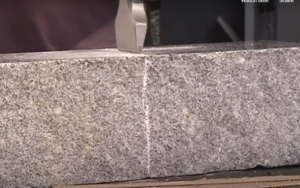Home » Journal Articles » Thoughts & Opinions » Stone Queries: Stone Tapping – Sept/Oct 2007

Ed: Ron Geitgey (pronounce it GET chee) was a long-time member of NWSSA, was a professional geologist for 40 years and was a talented sculptor and photographer. In 2002 and 2003 the Journal ran an informative series entitled “Stone Queries” in which Ron answered questions that the membership had about stone. We hope that you who remember the series appreciate the review and that you newcomers will find his breadth of knowledge and practical advice helpful.
I have noticed people choosing stone to carve by tapping the stone and listening. What are they doing?
Tapping the stone is an attempt to determine if the stone has any fractures. Some stones go thud, some ring, and some buzz or sound “odd.” Supposedly, a stone that rings has no fractures. Based on many years of experience as a stone carver and even more as a geologist collecting samples in the field, I consider the method unreliable, or at least one to use with caution. The presence or absence of fractures is only one of many factors that may affect the tonal qualities of stone.
Ringing is not necessarily dependent on stone type. Alabaster, some Soapstones, limestones, travertines, and sandstones may ring, or not, and be completely fracture free. Other stone, including marble, may ring nicely and still fracture during carving. In general, more brittle stones ring better; black marble, flint and obsidian are extreme examples.
The shape and means of support strongly affect ringing. A shapeless lump of stone is unlikely to ring while a thin bar or slab of the same stone may ring clearly. A stone lying on the ground or held in hand may not ring because its vibration is damped or muffled by the ground or the grip. A stone suspended by wire or rope, or one resting on narrow supports can vibrate much more freely. (So can one struck while being tossed in the air but that approach has obvious limits and hazards.) Suspended and supported stones have been used as musical instruments for millennia as gongs and xylophones, or more correctly, “lithophones.”
Finally, ringing can depend on the striking tool. A loosely held point or chisel can generate a clear tone but it’s not the stone that’s ringing.
So where does that leave us? Use a hammer, tap lightly, and be aware of shape and support. Test many pieces of stone to learn its typical sound, and listen for an abnormal sound or buzz. Of course you have learned something if the stone splits when you tap it. And accept the fact that stone is a natural material with natural variations. It is not a medium for those who don’t deal well with surprises.



We need some kind of descriptive text here.